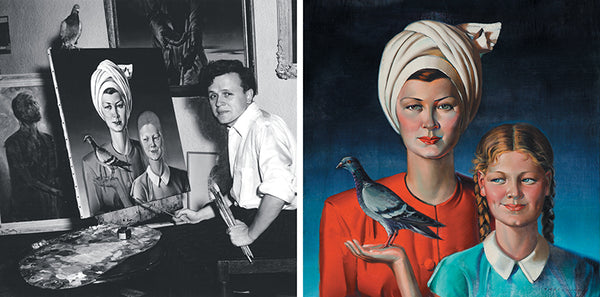Schkoora – the pigeon who inspired Tretchikoff

Vladimir Tretchikoff found an unlikely source of inspiration in a pigeon he named Schkoora. The bird boldly wandered into Tretchikoff and his wife Natalie’s flat one day, making itself at home and quickly becoming a cherished member of the family. The couple took the pigeon’s arrival as a good omen, as in Russia, a bird visiting one’s home is considered a sign of good luck.
Schkoora soon began to inspire Tretchikoff’s artwork. The pigeon features prominently in the painting ‘Artist’s Family’, where Tretchikoff’s daughter Mimi holds it in her hands. As Tretchikoff worked towards his first exhibition, he viewed Schkoora as a bearer of fortune, especially noting the bird’s silver identification ring with digits adding up to the number 13, a number the artist considered his lucky number.
However, Schkoora’s early morning activities became a nuisance for the couple, leading to the bird being reluctantly shooed away from their home. The departure of Schkoora brought about a sense of loss and guilt in the couple’s life, which was only abated when the pigeon returned and forgave them, making the bathroom its loft. The family was heartbroken when Schkoora disappeared one day, fearing they had lost their feathered friend forever.
The pigeon’s influence in Tretchikoff’s life didn’t end there. As the artist prepared for his second exhibition in Cape Town, a surprising reunion took place. Tretchikoff was approached for an interview by Richard Buncher, an announcer from the South African Broadcasting Corporation. The artist, along with his wife Natalie and their daughter Mimi, visited Buncher's home one sunny Sunday afternoon to discuss the upcoming radio appearance.
During the visit, amidst the pleasant ambiance of the garden and the playful antics of Buncher's children, a pigeon descended from the rooftop. Landing close to Tretchikoff, the bird instantly struck a familiar chord in the artist's heart – it was Schkoora.
The pigeon, recognised by his distinctive silver identification ring and the sum of 13 formed by its digits, had apparently been residing with Buncher's family after being found injured and nursed back to health. Tretchikoff demonstrated his previous connection with Schkoora, coaxing a ticklish response from the bird, much to the disbelief of their host.
The reappearance of Schkoora in Tretchikoff's life, just before the opening of his second exhibition, was seen as an uncanny yet fortunate event. The artist and his wife accepted this surprise return as a good omen, viewing it as a continuation of the serendipity that had accompanied the bird's initial presence in their home.
News of the reunion caught the attention of a young columnist, Bruce Heilbuth from the Cape Argus. Despite Tretchikoff's initial reservations about publicising the incident, Heilbuth's curiosity and persistence won out. The artist shared a photograph of Schkoora and details about their unique bond, which the columnist included in an extensive piece about Tretchikoff's life and work.
The fascinating tale of Tretchikoff and Schkoora ended up capturing the public's imagination, drawing an even larger crowd to the second exhibition than the first.
And so this unassuming pigeon became an integral part of Tretchikoff’s life and narrative – including the title of his autobiography Pigeon’s Luck – proving that muses can sometimes flutter into our lives in the most unexpected forms.
